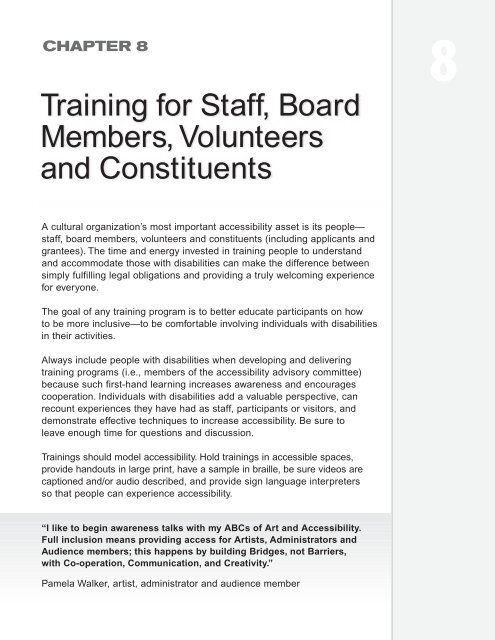Design for Accessibility: A Cultural Administrator's Handbook
Design for Accessibility: A Cultural Administrator's Handbook
Design for Accessibility: A Cultural Administrator's Handbook
You also want an ePaper? Increase the reach of your titles
YUMPU automatically turns print PDFs into web optimized ePapers that Google loves.
CHAPTER 8<br />
Training <strong>for</strong> Staff, Board<br />
Members, Volunteers<br />
and Constituents<br />
8<br />
A cultural organization’s most important accessibility asset is its people—<br />
staff, board members, volunteers and constituents (including applicants and<br />
grantees). The time and energy invested in training people to understand<br />
and accommodate those with disabilities can make the difference between<br />
simply fulfilling legal obligations and providing a truly welcoming experience<br />
<strong>for</strong> everyone.<br />
The goal of any training program is to better educate participants on how<br />
to be more inclusive—to be com<strong>for</strong>table involving individuals with disabilities<br />
in their activities.<br />
Always include people with disabilities when developing and delivering<br />
training programs (i.e., members of the accessibility advisory committee)<br />
because such first-hand learning increases awareness and encourages<br />
cooperation. Individuals with disabilities add a valuable perspective, can<br />
recount experiences they have had as staff, participants or visitors, and<br />
demonstrate effective techniques to increase accessibility. Be sure to<br />
leave enough time <strong>for</strong> questions and discussion.<br />
Trainings should model accessibility. Hold trainings in accessible spaces,<br />
provide handouts in large print, have a sample in braille, be sure videos are<br />
captioned and/or audio described, and provide sign language interpreters<br />
so that people can experience accessibility.<br />
“I like to begin awareness talks with my ABCs of Art and <strong>Accessibility</strong>.<br />
Full inclusion means providing access <strong>for</strong> Artists, Administrators and<br />
Audience members; this happens by building Bridges, not Barriers,<br />
with Co-operation, Communication, and Creativity.”<br />
Pamela Walker, artist, administrator and audience member


